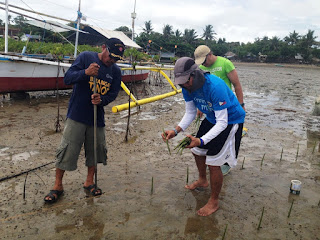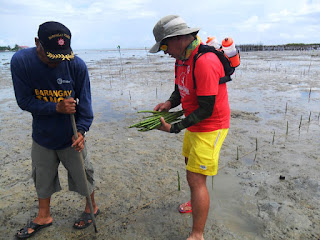The past few years the community outreach activity of our Ateneo de Naga Hight School Batch 1983 have been about donating slippers and school supplies to school children of elementary public schools located in the most remote areas of our Bicol region. The farther it is to urban civilization, the more we like to go. Thus, we have crossed the deepest lake in our region and we have crossed rough sea waves in our pursuit of being running men for others.
For the year 2015, donating slippers/school suppliers was not to be our altruistic activity. In April, as we planned our outreach activity, our main man in Camarines Norte, Epok Dacudao informed us that this was not tenable as the school children were still not back to school due to the summer vacation. If we were to have an outreach this summer, it will have to be a different one. Tree planting in the mountains was also out of the question as hiking up would not be ideal in the intense summer heat. Somebody proposed then a different kind of tree planting. How about Mangrove tree planting?
It really made sense. Mangrove tree planting combines our love for the environment and our love for the beach. To know more about mangroves, I googled about it and an article by Kennedy Warne of the National Geographic Magazine fascinated me the most. It talks about mangoves as living life on the edge. "With one foot on land and one foot on sea, these botanical amphibians occupy a zone of desiccating heat, choking mud, and salt levels that would kill an ordinary plant within hours. Yet the forests mangroves form are among the most productive and biologically complex ecosystems on Earth...As a group, mangroves can't be defined too closely. There are some 70 species from two dozen families - among them plam, hibiscus, holly, plumbago, acathus, legumes, and myrtle. They range from prostrate shrubs to 200-foot-high timber trees. Though most prolific in Southeast Asia, where they are thought to have originated, magroves circle the globe...They're brilliant adapters. Each mangrove has an ultrafiltration system to keep much of the salt out and a complex root system that allows it to survive in the intertidal zone. Some have snorkel-like roots called pneumaphores that stick out of the mud to help them toake in air; others use prop roots or buttresses to keep their trunks upright in the soft sediments at tide's edge."

We then requested our classmate Epok to look for us a coastal barangay in his province of Camarines Norte willing to host us do mangrove tree planting. After a day, he came back to us with the good news. There is this barangay in the town of Mercedes that has a mangrove tree planting program. The name of the barangay is Manguisoc.
In no time, we made preparations and we recruited willing bodies from our HS Batch 1983. There were seven of us: Epok, Bob Castilla, Ernie Badong, Ed Balcueva, Bodjie Importante, Allen Tolledo and myself. To augment the 7, Epok recruited help from 3 Barangay tanods from our host barangay. By the morning of May 2, we were at the Mercedes fish port by the banks of ready to ferry into the opposite side of the river where Barangay Manguisoc is located.
 |
| Mercedes Fish Port |
 |
| "Mangrove 7": Bob, Ed, Ernie, Bodjie, Allen, Epok and the Bicolano Penguin |
 |
| Waiting for the ferry. |
The ferry across was less than 10 minutes and we were soon disembarking in our host barangay. We went straight to the Barangay Hall where Barangay Captain Eduardo Canarejo was meeting with the barangay council.The barrio chief excused himself from the meeting and took time to show us the place where we will plant and teach us a thing or two on mangrove tree planting. He had this 1/3 2/3 rule. 1/3 of the propagules to be buried on the ground, 2/3 to be exposed. After his coaching, we had the customary group photo with our hosts.
 |
| The ferry boat |
 |
| Excited to be in Manguisoc |
 |
| Touchdown in Manguisoc |
 |
| Getting pointers on handling a mangrove propagule from Kagawad Totanes. |
 |
| A sack of propagules. We bought several sacks of propagules from the barangay. |
 |
| Exchanging pleasantries with the Barangay Captain |
 |
| Group photo with the barangay officials |
Then we were off to the shore where we will plant. The objective was to plant 1,000 mangrove propagules in less than 2 hours. The cut off time was more a function of the tides rather than mealtime. We should be finished before lunchtime as by 12 noon, the tides would be coming in. Better to plant mangroves in the low tide rather than the high tide.
1,000 mangroves in 2 hours. Was it possible? Doing the math, it seemed a stretch as 1,000 divided among 7 planters meant 143 propagules. Dividing it further by 2 hours, it meant that each one of us should be able to plant at the rate of 71 per hour or more than 1 per minute. It can be done but but we had to do it an efficient way. But how? All 7 from Batch 83 had no previous experience in mangrove tree planting. The ones with experience where the 3 barangay tanods and they told us that previous mangrove tree planting exercises that their barangay hosted involved hundreds of school children and public officials. We were less than a dozen.
Unperturbed, we proceeded to literally and figuratively have our feet wet. We initially had all 7 of us taking turns in planting the propagules on the ground. It was back breaking for some of us as we continually have to bend our back to reach the ground. After witnessing this inefficient way, we huddled up again and decided to break our 7 + 3 into 3 teams of 3 members each. The first member will make the hole, the second member will put the propagule on the hole (following the 1/3 rule), and the trailing third member will be the one to firm up the propagule on the ground.
With this modification on our execution, progress moved at a quicker pace. We got better at it. And soon, our worrisome faces evolved into smiling faces. Then the joking started, mostly of the green variety. Somebody blurted out a title for a movie: "Hahawakan ko Bakawan Mo ". Someone posed a question that needed answering: "Saan tinatanim ang bakawan?". Answer: "sa basa." Would green thumbs necessarily come from green minds? Or is it the other way around?
With all the green jokes flying around, we did not realize that we were down to our last 50 propagules. And in less than 10 minutes, they were all planted. Time for our group photo.
It was surely a rewarding experience for us. Our first crack at mangrove tree planting and we did good time. Another request was given to Epok. Find us another coastal barangay, preferably on an island, where we can groove again with the mangroves.
P.S. Our Ateneo de Naga HS Batch 1983 found inspiration in the earlier mangrove tree planting/coastal marine protection activities of Ateneo de Naga HS Batch 1990 (AdeNubenta) and Bicol University HS Batch 1986 (BUHS Tribu 86). This April 18, 2015, AdeNubenta together with its counterpart batch in the University of Santa Isabel (USI) planted 5,000 mangroves in Caaluan, Tinambac, Cam. Sur. Much earlier, in March 20, 2011, BUHS Tribu 86 organized the Ridge Run for Reef which benefited the Uson Fishing Sanctuary and Marine Reserve in Bacacay, Albay.


































2 comments:
BP, 83neans always love SECS.....school,environment,community,
scholarship
Salamat Allen. Por da lab ang dating mo talaga.
Post a Comment